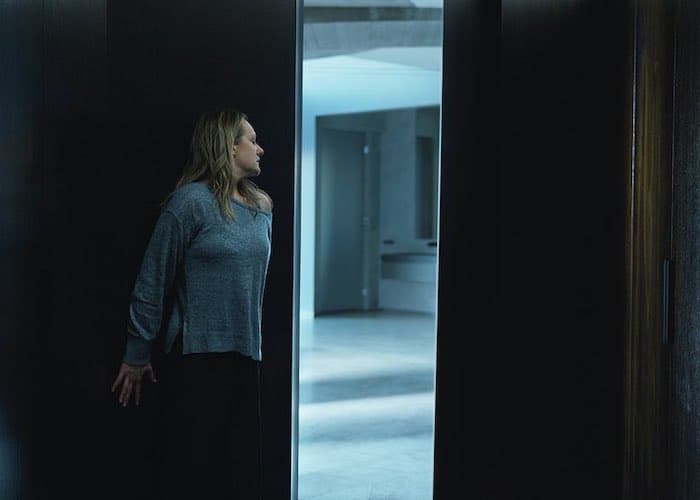Leigh Whannell‘s reimagined Invisible Man is a more terrifying and menacing Universal Monster for modern times. Before his “death,” he was an abusive, controlling husband to a trapped Cecilia Kass, played by Elisabeth Moss. Knowing that he is capable of real evil makes waiting for him to inflict that evil on Cecilia and the people she loves excruciating to watch but in the most thrilling way. Whannell’s monster is not the only thing that keeps the audience on edge throughout The Invisible Man. The strategic cinematography of Stefan Duscio never lets the audience relax; it even makes a complacent witness out of anyone who watches the film.
The remake starts off depicting Cecilia’s escape from her deranged and violently abusive husband, Adrian Griffin (Oliver Jackson-Cohen), and the camerawork stands out from the very first scene. There are languid shots of Cecilia as she tip-toes through the mansion while Adrian sleeps, unaware that she is leaving him. Adrian may be unconscious, but one shot as Cecilia hastily dresses and grabs her things still makes the audience feel like someone else is watching. The camera pans from a wide frame from the hallway to a shot of the long hallway, but it’s empty.
This is a great way to keep the audience wondering, waiting for Adrian to wake up and hurt her. He never comes to, but that anticipation for something lying in the empty spaces that are deliberately shown onscreen lingers with the audience. Some filmmakers might have chosen to stay close to Cecilia, to focus on her face in order to show the audience how nervous she is and to relay that emotion to them. Duscio stays back, unafraid to show the story from the point of view of the hidden corners.
Once Cecilia is safe with James (Aldis Hodge) and his daughter Sydney (Storm Reid), the camera still never allows the audience to enjoy the relief that the characters are feeling in the scenes. They watch as the characters celebrate Christmas but look on from another room. There are several moments like this in the film, where the shot is framed as to exclude the audience from being in the scene itself.
This creates a few feelings for the audience. One effect is the framing makes the audience feel much like the Invisible Man. They know he is lurking somewhere close by, even if they cannot see him. That is evident by the holds on empty space and pans to parts of the house other characters aren’t occupying. However, they are looking in on Cecilia from a distance, just as he is. These moments when they are watching her are when she is most vulnerable and it makes the audience uncomfortable. As they become the voyeur in the situation, they are not far from being the monster, too.
The other effect it has on the audience is giving them complete powerlessness. They observe from a distance, see more than just what Cecilia can see, but they cannot do anything about it. Like her friends who cannot see what she worries about, they cannot help her, only watch the destruction Adrian causes. It’s torturous for the audience, in a way that makes for a great horror film.
It’s also incredibly fitting considering the subject of the movie. Cecilia’s abusive relationship is based on the experiences women face in real relationships. How many of us have sat idly by when there were clear signs that a woman is being physically or emotionally abused? In The Invisible Man, they must watch and think about all the ways they would help if only they could. It’s frustrating for the audience, but in a way that should stay with them after they walk out of the theater. Perhaps they will choose to be more than a witness to the abuse and step further into the frame to help.
Where this camerawork could be a gimmick for the sake of style, it is rightfully pulled off in The Invisible Man. Focusing on blank space makes the audience search the frame for signs of the Invisible Man. They might catch a glimpse of a knife he is wielding, or the shot might create a diversion to surprise the audience when they are focused on something else. This works because what they are scared of in the film is that which they cannot see.
Whannell and Duscio use the camera to create anticipation in a way that serves the tone of the film as well. There is just enough restraint in the cinematography that the camerawork doesn’t get in the way of the story but keeps the audience interested in what is invisible to them. What ends up being the most terrifying aspect of the film is not what is invisible, but the audience’s complacent role in Cecilia’s story as they are forced to witness her torture as a not-so-innocent bystander.

